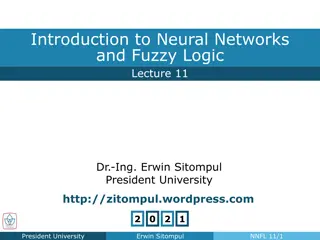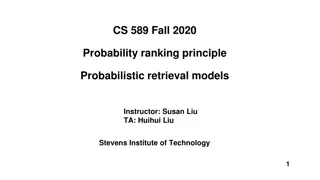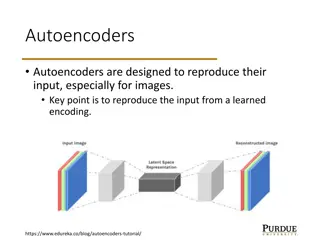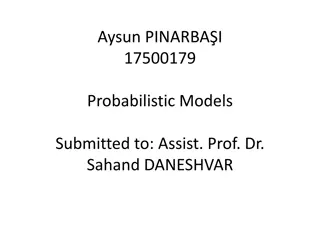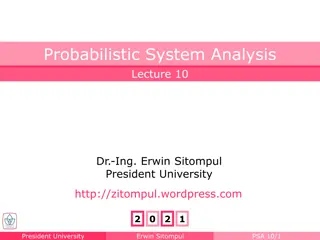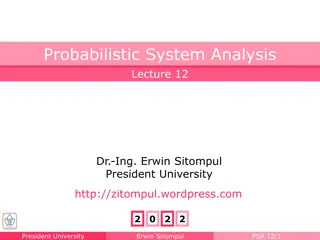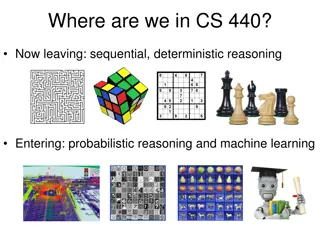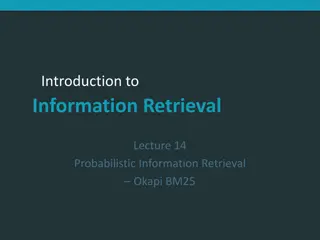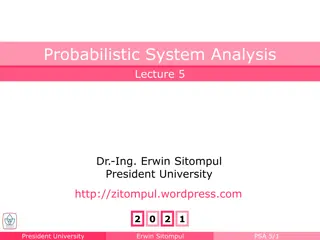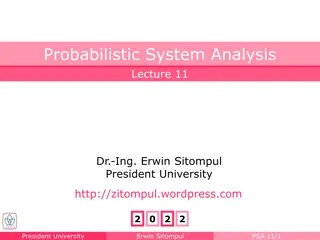Understanding Probabilistic System Analysis with Dr. Erwin Sitompul
Explore an in-depth discussion on probabilistic system analysis in these lectures by Dr. Erwin Sitompul from President University. Topics include random variables, probability distributions, mathematical expectation, and more. Gain insights into calculating probabilities and expected values for continuous random variables. Enhance your knowledge with exercises on determining PDF values and probabilities for computer function times. Dive into understanding the mean of a random variable and its significance in scenario analysis.
- Probabilistic System Analysis
- Dr. Erwin Sitompul
- President University
- Probability Distributions
- Mathematical Expectation
Download Presentation

Please find below an Image/Link to download the presentation.
The content on the website is provided AS IS for your information and personal use only. It may not be sold, licensed, or shared on other websites without obtaining consent from the author. Download presentation by click this link. If you encounter any issues during the download, it is possible that the publisher has removed the file from their server.
E N D
Presentation Transcript
Probabilistic System Analysis Lecture 4 Dr.-Ing. Erwin Sitompul President University http://zitompul.wordpress.com 2 0 2 2 President University Erwin Sitompul PSA 4/1
Chapter 3 Random Variables and Probability Distributions Some Exercises Supposed that X is a continuous random variable value whose PDF is given by 2 (4 2 ), 0 2 ( ) 0, elsewhere C x x x = f x (a) Determine the value of C. (b) Find P(X>1) f x dx 2 2 C 2 3 3 8 2 = = = (4 2 ) x x dx = 2 3 ( ) 1 (2 ) 1 C x x C (a) 0 0 2 2 3(4 8 3 8 2 3 1 2 = = = = 2 2 3 2 ) x x dx (2 ) x x ( 1) ( ) f x dx (b) P X 1 1 1 President University Erwin Sitompul PSA 4/2
Chapter 3 Random Variables and Probability Distributions Some Exercises The amount of time, in hours, that a computer functions before breaking down is a continuous random variable with PDF given by 100, 0 ( ) 0, 0 x x e x = f x (a) What is the probability that a computer will function between 50 and 150 hours before breaking down? (b) What is the probability that it will function less than 100 hours? = P (a) 0.01 (50 150) 0.384 X (b) ( 100) 0.633 P X President University Erwin Sitompul PSA 4/3
Chapter 4 Mathematical Expectation Chapter 4 Mathematical Expectation President University Erwin Sitompul PSA 4/4
Chapter 4.1 Mean of a Random Variable Mean of a Random Variable If two coins are tossed 16 times and X is the number of heads that occur per toss, then the values of X can be 0, 1, and 2. Suppose that the experiment yields no heads, one head, and two heads a total of 4, 7, and 5 times, respectively. The average number of heads per toss of the two coins is then (0)(4) (1)(7) (2)(5) 1.06 16 + + = The value means that on average we can expect that by each toss the head will occur for 1.06 times and no head for 0.94 times. 1.06 is called an expected value, a term used to describe the long- term average outcome of a given scenario. President University Erwin Sitompul PSA 4/5
Chapter 4.1 Mean of a Random Variable Mean of a Random Variable Let X be a random variable with probability distribution f(x). The mean or expected value of X is = if X is discrete, and = ( ) E X ( ) xf x x = = ( ) E X ( ) xf x dx if X is continuous. President University Erwin Sitompul PSA 4/6
Chapter 4.1 Mean of a Random Variable Mean of a Random Variable A lot containing 7 components is sampled by a quality inspector, the lot contains 4 good components and 3 defective components. A sample of 3 is taken by the inspector. Find the expected value of the number of good components in this sample Let X represent the number of good components in the sample. The probability distribution of X is C C f x x C 1 (0) , 35 35 35 = = 4 3 3 ( ) , 0,1,2,3 x x for 7 3 12 18 4 = = = = (1) , (2) , (3) f f f f 35 1 35 12 35 18 35 4 12 7 = = + + + = = = (0) (1) (2) (3) ( ) E X ( ) 1.714 xf x 35 x Thus, if 3 components are selected at random over and over again from a lot of 4 good components and 3 defective components, one will pick on average 1.7 good components and, accordingly, 1.3 bad components. President University Erwin Sitompul PSA 4/7
Chapter 4.1 Mean of a Random Variable Mean of a Random Variable In a gambling game a man is paid $5 if he gets all heads or all tails when three coins are tossed, and he will pay out $3 if either one or two heads show. What is his expected gain? The sample space for the possible outcomes of this game is { , , , , S HHH HHT HTH THH HTT THT TTH TTT = Each of these events is equally likely and occurs with probability of each equal to 1/8. Let Y be the amount of money the gambler can win, E1 is the event of winning 5$ and E2 is event of losing $3, { , } E HHH TTT = { , , , , , E HHT HTH THH HTT THT TTH = = (5) ( 3) 4 , , , } y 5 3 = = 1 4 3 4 ( ) f y [ ] P Y y 1 } 2 1 3 4 = + = = 1 ( ) ( ) E Y yf y y In this game the gambler will, on average, loss $1 per toss of the three coins. President University Erwin Sitompul PSA 4/8
Chapter 4.1 Mean of a Random Variable Mean of a Random Variable A salesperson has two appointments on a given day. He believes that he has 70% chance to make the deal at the first appointment, from which he can earn $1000 commission if successful. On the other hand, he thinks he only has a 40% chance to make the deal at the second appointment, which will give him $1500 if successful. What is his expected commission based on his own probability belief? Assume that the appointment results are independent of each other. Let X be the commission the salesperson will earn. Due to independence, the probabilities can be calculated as ($0) (1 0.7)(1 0.4) 0.18 f = = ($1000) (0.7)(1 0.4) 0.42 f = = = = = = ($1500) (1 0.7)(0.4) 0.12 f ($2500) (0.7)(0.4) 0.28 f = = ( ) E X ( ) xf x x = ($0)(0.18) ($1000)(0.42) ($1500)(0.12) ($2500)(0.28) + + + = $1300 President University Erwin Sitompul PSA 4/9
Chapter 4.1 Mean of a Random Variable Mean of a Random Variable Let X be the random variable that denotes the life in hours of a certain electronic device. The probability density function is 20,000, 100 ( ) 0, elsewhere x = f x 3 x Find the expected life of this type of device. 20,000dx x 20,000 x 20,000 x = = = 200 = = = x dx ( ) E X ( ) xf x dx 2 3 100 100 100 Therefore, we can expect this type of device to function well for, on average, 200 hours. President University Erwin Sitompul PSA 4/10
Chapter 4.1 Mean of a Random Variable Mean of a Random Variable Let X be a random variable with probability distribution f(x). The mean or expected value of the random variable g(X) is ( ) ( ) ( ) ( ) g X E g X g x f x = if X is discrete, and = = = ( ) ( ) ( ) g x f x dx E g X ( ) g X if X is continuous. President University Erwin Sitompul PSA 4/11
Chapter 4.1 Mean of a Random Variable Mean of a Random Variable Suppose that the number of cars X that pass through a car wash between 4:00 P.M. and 5:00 P.M. on any sunny Friday has the following probability distribution: Let g(X)=2X 1 represent the amount of money in dollars, paid to the attendant by the manager. Find the attendant s expected earnings for this particular time period. 9 = = ( ) 2 1 E g X E X (2 1) ( ) f x x = 4 x ($7) 1 1 1 4 1 4 = + + + ($9) ($11) ($13) 12 12 1 6 1 6 + + ($15) ($17) = $12.67 President University Erwin Sitompul PSA 4/12
Chapter 4.1 Mean of a Random Variable Mean of a Random Variable Let X be a random variable with density function 2 , 1 2 ( ) 3 0, elsewhere x x = f x Find the expected value of g(X)=4X+3. 2 2 + 2 4 3 x x x = = 8 = + = (4 3) x dx ( ) ( ) ( ) g x f x dx E g X 3 3 1 1 President University Erwin Sitompul PSA 4/13
Chapter 4.1 Mean of a Random Variable Mean of a Random Variable Let X and Y be random variables with joint probability distribution f(x,y). The mean or expected value of the random variable g(X,Y) is ( , ) ( , ) ( , ) ( , ) g X Y x y if X and Y are discrete, and = = E g X Y g x y f x y = g X Y = ( , ) ( , ) ( , ) g x y f x y dxdy E g X Y ( , ) if X and Y are continuous. President University Erwin Sitompul PSA 4/14
Chapter 4.1 Mean of a Random Variable Mean of a Random Variable Let X and Y be a random variables with joint probability density function as in the ballpoint pens example. Find the expected value of g(X,Y)=XY 2 2 = ( , ) E XY xyf x y = = 0 0 x y 3 28 3 1 28 9 28 3 = + + + + + (0)(0) (0)(1) (0)(2) (1)(0) (1)(1) 14 14 3 28 + + + (1)(2)(0) (2)(0) (2)(1)(0) (2)(2)(0) 3 = 14 President University Erwin Sitompul PSA 4/15
Chapter 4.1 Mean of a Random Variable Mean of a Random Variable Find E(Y/X) for the density function (1 3 ( , ) 4 0, + 2 ), 0 x y 2,0 1 x y = f x y elsewhere 1 2 (1 3 + 2 ) Y X y x x y = E dxdy 4 0 0 1 2 + 3 3 y y = dxdy 4 0 0 1 2 4 3 16 y y 2 = + x 0 8 0 5 8 = President University Erwin Sitompul PSA 4/16
Probabilistic System Analysis Homework 4A 1. From a regular deck of 52 playing cards we pick one at random. Let the random variable X equal the number on the card if it is a numbered one (ace counts as 1) and 10 if it is a face card (J, Q, and K). Find E(X). 1 2 3 4 5 6 7 8 9 10 10 10 10 2. Four indistinguishable balls are distributed randomly into 3 distinguishable boxes. Let X denote the number of balls that end up in the first box. Find E(X). (Sch.E5.1.1-2) President University Erwin Sitompul PSA 4/17






